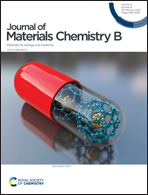A natural biogenic fluorapatite as a new biomaterial for orthopedics and dentistry: antibacterial activity of lingula seashell and its use for nanostructured biomimetic coatings†
Abstract
Calcium phosphates are widely studied in orthopedics and dentistry, to obtain biomimetic and antibacterial implants. However, the multi-substituted composition of mineralized tissues is not fully reproducible from synthetic procedures. Here, for the first time, we investigate the possible use of a natural, fluorapatite-based material, i.e., Lingula anatina seashell, resembling the composition of bone and enamel, as a biomaterial source for orthopedics and dentistry. Indeed, thanks to its unique mineralization process and conditions, L. anatina seashell is among the few natural apatite-based shells, and naturally contains ions having possible antibacterial efficacy, i.e., fluorine and zinc. After characterization, we explore its deposition by ionized jet deposition (IJD), to obtain nanostructured coatings for implantable devices. For the first time, we demonstrate that L. anatina seashells have strong antibacterial properties. Indeed, they significantly inhibit planktonic growth and cell adhesion of both Gram-positive Staphylococcus aureus and Gram-negative Escherichia coli. The two strains show different susceptibility to the mineral and organic parts of the seashells, the first being more susceptible to zinc and fluorine in the mineral part, and the second to the organic (chitin-based) component. Upon deposition by IJD, all films exhibit a nanostructured morphology and sub-micrometric thickness. The multi-doped, complex composition of the target is maintained in the coating, demonstrating the feasibility of deposition of coatings starting from biogenic precursors (seashells). In conclusion, Lingula seashell-based coatings are non-cytotoxic with strong antimicrobial capability, especially against Gram-positive strains, consistently with their higher susceptibility to fluorine and zinc. Importantly, these properties are improved compared to synthetic fluorapatite, showing that the films are promising for antimicrobial applications.



 Please wait while we load your content...
Please wait while we load your content...